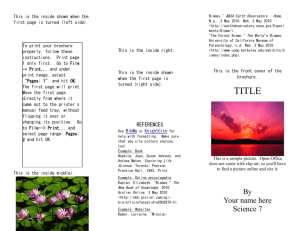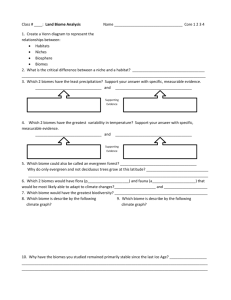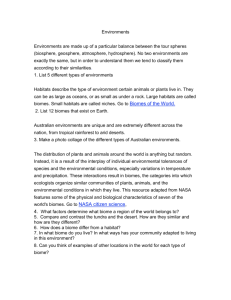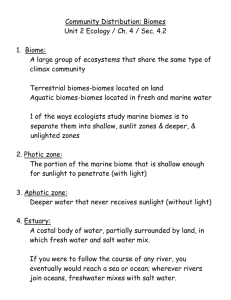What is a Biome
advertisement
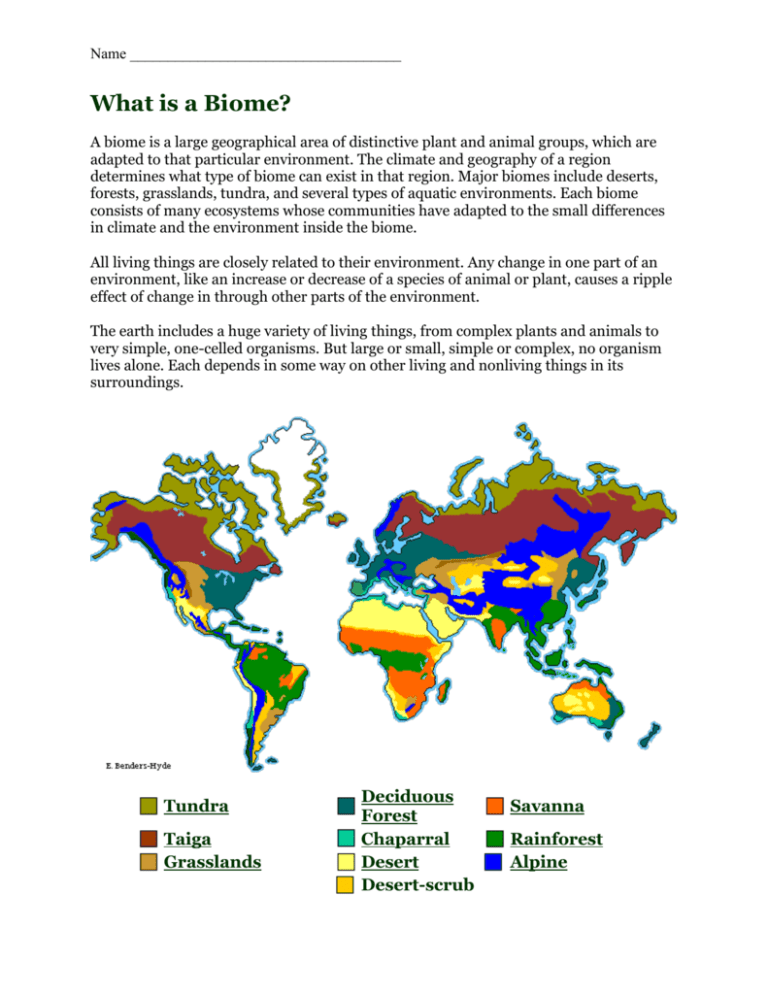
Name ____________________________________ What is a Biome? A biome is a large geographical area of distinctive plant and animal groups, which are adapted to that particular environment. The climate and geography of a region determines what type of biome can exist in that region. Major biomes include deserts, forests, grasslands, tundra, and several types of aquatic environments. Each biome consists of many ecosystems whose communities have adapted to the small differences in climate and the environment inside the biome. All living things are closely related to their environment. Any change in one part of an environment, like an increase or decrease of a species of animal or plant, causes a ripple effect of change in through other parts of the environment. The earth includes a huge variety of living things, from complex plants and animals to very simple, one-celled organisms. But large or small, simple or complex, no organism lives alone. Each depends in some way on other living and nonliving things in its surroundings. Tundra Taiga Grasslands Deciduous Forest Chaparral Desert Desert-scrub Savanna Rainforest Alpine To understand a world biome, you need to know: What the climate of the region is like. Where each biome is found and and what its geography is like. The special adaptations of the vegetation. The types of animals found in the biome and their physical and behavioral adaptations to their environment. Ecological Relationships of Biomes The survival and well being of a biome and its organisms depends on ecological relationships throughout the world. Even changes in distant parts of the world and its atmosphere affect our environment and us. The eruption of a volcano in Mexico, or Southeast Asia can bring the temperature of the whole world down a few degrees for several years. Source: http://www.blueplanetbiomes.org/world_biomes.htm You should be aware that the definition of a biome can vary, with some sources identifying many more than those listed above, and others lumping a number of categories together. In addition, a variety of aquatic biomes can also be identified, with freshwater and marine (saltwater) being the minimum. We will take a quick tour through most of the earth’s major biomes by using the “Pole to Pole” segment of the “Planet Earth” video series. For each biome, consider the general climate, major characteristics of the producers and relations of the consumers to their food. The questions will guide you, but you may need to consult other sources to complete the descriptions. The website above would be a good place to start! Polar Regions Koeppen Classification: Defining characteristics: Producers: Consumers: Animal Adaptations/behaviors/notes from video: Male Emperor penguins: Polar Bears: What must the mother polar bear do soon? 2 Tundra Koeppen Classification: Defining characteristics: Producers: Consumers: Animal Adaptations/behaviors/notes from video: What strategy is used by the primary consumers to cope with seasonal changes in food supply? Adult caribou in spring are whitish while the young are light brown. Why might this be the case? Why aren’t there trees? Taiga/Boreal forest Koeppen Classification: Defining characteristics: Producers: Consumers: Animal Adaptations/behaviors/notes from video: Why isn’t there much animal life to consider most of the year? Why is this biome tremendously important? Deciduous/Temperate Forest Koeppen Classification: Defining characteristics: Producers: Consumers: Animal Adaptations/behaviors/notes from video: What strategy is used by the primary consumers to cope with seasonal changes in food supply? What is special about the Amur Leopard? 3 Note: Why are there seasons in most biomes? Tropics/Rainforest Koeppen Classification: Defining characteristics: Producers: Consumers: Animal Adaptations/behaviors/notes from video: Why is this a seasonless biome? About what percentage of the earth’s plant and animal species live here? As you descend from the dense canopy (tree tops) to the forest floor, how does the environment change? About how much of the available sunlight reaches the forest floor? The courtship behaviors of males of two bird species are shown. What appears to be particularly important in each of these species? Sketch or describe in words. Six-plume bird: Bird of Paradise: Oceans – more on these to come! Defining characteristics: Producers: Consumers: Is sunlight important here? Why is the zone where the waves reach the shore (intertidal zone) so productive? A major marine predator is shown. Why is it in this place at this time? What drives its migration? Winds are generated at sea. What impact do these have on continental systems? 4 Summarize the water cycle: Desert (see below for the Kalahari Desert!) Koeppen Classification: Defining characteristics: Producers: Consumers: Dry Savanna (the Kalahari “desert”) Koeppen Classification: Defining characteristics: Producers: Consumers: Animal Adaptations/behaviors/notes from video: What strategy is used by the primary consumers to cope with seasonal changes in food supply? What is special about the Okavango River Delta? What happens when water arrives in the Okavango Delta – much of it originating far north in Angola? What makes the African hunting dogs such effective predators? Can elephants swim??? 5 Antarctica in spring – what is happening here? Wrapping up… Our tour of the biomes has generally taken us through the northern latitudes to the equatorial regions. Why not continue through the southern latitudes? Why don’t we find much deciduous forest, or any taiga or tundra in the southern hemisphere? Aquatic Biomes Go to http://www.ucmp.berkeley.edu/exhibits/biomes/index.php for information on Freshwater and Marine Biomes. Freshwater What defines each of the major zones in a pond or lake? Littoral Limnetic Profundal Marine What defines each of the major zones in an ocean? Intertidal Pelagic Benthic Abyssal 6 Estuaries – what happens where fresh and salt water meet? Why are estuaries, and wetlands in general, critical environments? 7



